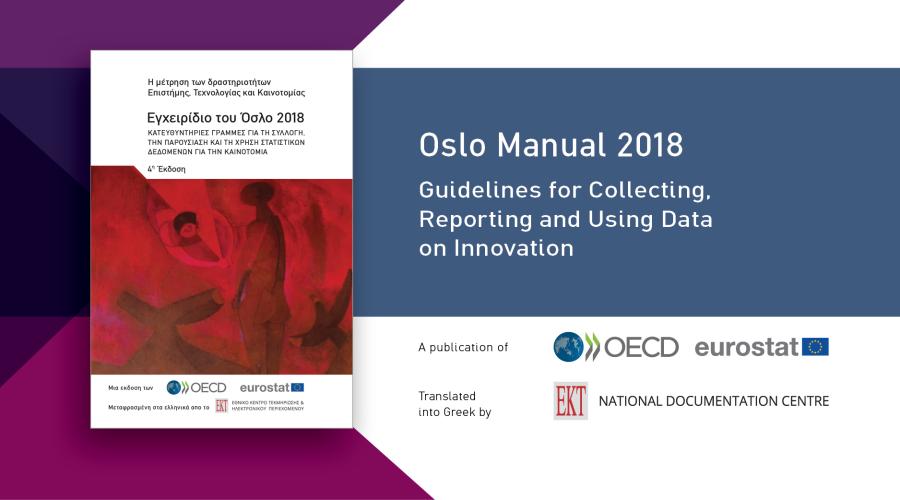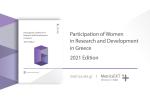
The National Documentation Centre (EKT) has translated the latest edition of the flagship publication: the Oslo Manual, the international reference guide for measuring innovation, into Greek. The publication: ‘Oslo Manual 2018, Guidelines for Collecting, Reporting and Using Data on Innovation, 4th Edition’ published in 2018 by the Organisation for Economic Co-operation and Development (OECD) in collaboration with the European Statistical Office Eurostat, is available, in Greek, at https://metrics.ekt.gr/publications/552.
The 4th edition of the aforementioned manual provides a modern conceptual framework for measuring innovation, ensuring the international comparability of business activities and results. The publication refers to innovation for business, for markets, for the economy and for the society as a whole. It highlights new fields of innovative applications and it is expected to be used in planning development actions for the forthcoming period in Greece, especially in the area of digital transformation by the public sector as a new and important actor in innovation.
The manual is a guide and source of inspiration for policy makers, senior public administration executives, especially those involved in the design and implementation of relevant public funding initiatives, business and management executives, the academic and research community and business and industry associations.
As the Director of EKT, Dr. Evi Sachini, points out in the foreword to the Greek edition, ‘In a world of vast information dissemination without documentation, such publications lay the groundwork for understanding contemporary and multifaceted concepts such as innovation. National Documentation Centre (EKT) is a public organization that measures and monitors the Greek ecosystem of research, technology, development, and innovation. On this account, the most contemporary, worldwide, conceptual, and terminological framework for innovation is offered in Greek language by EKT. Our goal is to strengthen statistical information and education and to launch a substantive dialogue on policy-making related to research, education and entrepreneurship’.
The history of the Oslo Manual begins 30 years ago, with the adoption of the general guidelines for measuring innovation, which were reached by the Working Group of National Experts on Science and Technology Indicators (NESTI team) of the OECD. This was the beginning of a period of great upheaval in the global economy, in which high growth rates were being recorded worldwide and, of course, the advent of the Internet. The first edition of the manual in 1992, covered solely the manufacturing sector and was focused on technology. That was also the basis of the first European survey to measure innovation in 1992, the CIS (Community Innovation Survey).
In the 4th upgraded edition of the Oslo Manual translated by EKT, a systematic approach to innovation is now used. Innovation ecosystems develop on a global and local scale in tandem; as networks and as internal capabilities of various organisations; as knowledge flows and as physical or digital skills; multiplying interconnectedly and interdependently. The 4th edition of the Oslo Manual guides users in measuring the internal and external factors that influence business innovation, and addresses the need to measure the impact of public policies on innovation. The collection of a larger set of data, coming from both non-innovative and innovative enterprises, is promoted to help explore the drivers and catalysts of innovation.
The aim is to understand the heterogeneous range of innovations and their impact on business, the market and the wider social context. Extensive methodological guidelines are provided for the entire life cycle of innovation data, from the design of statistical surveys and their control to the dissemination and editing of data. Users are supported by a new chapter, which explains the use of statistical data for indexing and analysis.
Future application of the new approach to measuring innovation is arousing great interest. The Oslo Manual is a basic methodological manual for the official pan-European CIS survey on enterprise innovation in the European Union, a European survey which in Greece is conducted by EKT. The new guidelines of the manual were first applied to the CIS survey with reference to the period 2016-2018, the results of which are available at https://metrics.ekt.gr/publications/449.
EKT’s role
EKT is the competent National Authority of the Hellenic Statistical System for the European statistics for Research, Development and Innovation in Greece, and produces national statistics in the fields of science & technology and the digital economy.
In this role, EKT represents Greece on the NESTI, international committees - Working Group of National Experts on Science and Technology Indicators, and CSTP - Committee on Scientific and Technological Policy of the OECD and is a member of the Eurostat Research Working Groups, Technology and Innovation. The revision of the Oslo Manual was an extensive and detailed process carried out within the framework of the work of these committees, with the guidance of the steering group and the participation of EKT and other members of statistical authorities and international experts.
Having established itself as a trusted partner and interlocutor in the OECD, EKT acts as a link, transferring and applying this knowledge to Greece through its actions. With this in mind and in co-operation with the OECD, EKT undertook the publishing of the Oslo Manual in Greek.
As the National Authority of the Hellenic Statistical System, EKT conducts the CIS survey on Enterprise Innovation, the official European statistical survey on innovation in the countries of the European Union, in Greece. The survey is conducted every two years in all EU member states through a single standard questionnaire, in accordance with European legislation, the methodological guidelines of the Oslo Manual and the Eurostat guidelines, ensuring high quality and comparability of the indicators of the EU member countries.
The new edition of the Oslo Manual has undergone significant changes in the definitions of innovation types. There are now two types of innovation: innovations that change business products (product innovations) and innovations that change business processes (business process innovations). The products include the goods and services of the company, or a combination thereof. Business processes include all of the enterprise’s core product-related activities and all other support activities. The new type of ‘business process innovation’ has partially replaced, without absolute comparability, the process innovation, organisational innovation and marketing innovation that were in place in previous years.
The Greek translation of the publication ‘Oslo Manual 2018, Guidelines for Collecting, Reporting and Using statistics on Innovation, 4th edition’ was carried out within the framework of Subproject 5 ‘Production of RIS3 indicators for the years 2016-2023’ of the project "Installation of a Monitoring Mechanism for the implementation of the national strategy RIS3-Collection and processing of Indicators’ , implemented by the National Documentation Centre (EKT) within the framework of the Operational Programme ‘Competitiveness, Entrepreneurship & Innovation 2014-2020 ‘ with the co-financing of Greece and the European Union-European Regional Development Fund.















